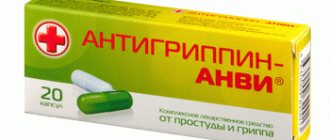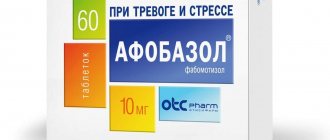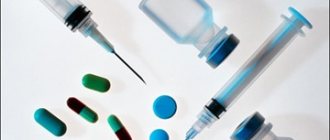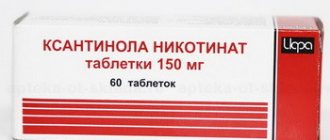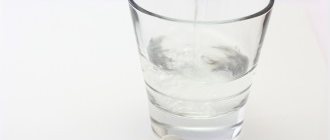Pharmacological action of the drug Venofer
Sucrose iron complex is a complex high-molecular compound. Due to its high mass, it is not excreted through the kidneys in its original form.
This complex has a high level of stability and does not release free iron ions. This complex is very similar to ferritin of natural origin.
The maximum concentration in the blood after the first infusion is reached after 10 minutes. The half-life of the drug is about 6 hours. The drug is distributed very poorly in body fluids.
Complete elimination occurs after 24 hours, after which the level of serum iron in the blood returns to its original values, and most of the sucrose is excreted from the body.
Indications for use
The main indication for use of the drug Venofer is the treatment of iron deficiency conditions of various origins:
- To quickly replenish the amount of iron in the body.
- If there is hypersensitivity to oral medications containing iron or the patient does not comply with the treatment regimen.
- If the patient has active inflammatory processes in the intestines, in which the administration of oral forms of iron-containing drugs is ineffective.
Contraindications
The following conditions are contraindications to the use of Venofer:
- anemia not associated with a lack of iron in the body;
- clinical signs of iron oversaturation in the body - hemosiderosis, symptoms of hemochromatosis;
- violation of the biological mechanisms of iron utilization in the body;
- individual intolerance or hypersensitivity to the drug or its individual components;
- pregnancy in the 1st trimester.
There are also conditions in which Venofer should be prescribed with extreme caution:
- Severe bronchial asthma.
- Polyvalent allergy to all preparations containing iron.
- Eczema.
- Low ability to bind iron ions in blood serum.
- Deficiency of folic acid in the body and its metabolites.
- Acute or chronic liver failure.
- Acute or chronic infectious diseases. This is due to the possibility of adverse effects from iron.
- In patients with elevated serum ferritin levels.
VENOFER (solution)
globin and low iron and also low ferritin (and it is responsible for the absorption of iron in the body), then I have a direct path to a hematologist.
My ferritin turned out to be not just low, but literally none. And I had to set off along the proposed road. At my destination, I was greeted unfriendly, fussy, and tried to talk the local therapist down (because it’s not the king’s business to raise hemoglobin levels for everyone; they, hematologists, have more serious problems). I had to remind myself that I paid money for the reception, honestly earned with the last of my strength. The blood doctor took mercy on me (this is the kind of doctor who treats blood diseases :-))), and suggested that I give something intravenously, like venofer. Like - not like, but I wrote a specific name in the recommendations. In addition, she gave one real practical advice, after which I will not call her a hematologist, but again I will call her a hematologist. “Lena,” said the hematologist, “contact your local physician so that he/she can send you to a day hospital, where they will treat you completely free of charge, and if you do it yourself for money, then the drug will cost about three thousand.” " Well, valuable advice, you agree!
There is no chance for me to go to a day hospital; I cannot take sick leave at work. I had to earn three thousand by spending the remaining 80 hemoglobins.
The receipt has not been preserved, but the price can be found on the Internet - almost three thousand for a box of five bottles. The bottles contain the drug specifically for intravenous administration; it is even highlighted in color for those who like to make holes in the soft places of their torso. Or maybe someone will want a drink. Also nigga!
Trivalent iron, doctors say, is absorbed by the human body better than divalent iron. But for me, at least some, as long as it doesn’t burn my stomach.
Upside down - this is some kind of joke from the manufacturer that I don’t understand. The letters are written normally, but the bottles in the box are upside down. Honestly, it wasn’t me who rearranged them like that. It would never have occurred to me.
I rearranged it normally - this is how they should stand, all five vials are made of transparent glass with cherry caps.
The big-eyed labels on the bottles have all the necessary information, I won’t rewrite it, you can read it all yourself in the photo.
The bottle has one very remarkable convenience. The cap-lid comes off with a characteristic click, and in the very middle there is a place for tingling with a needle to draw the drug. Remember how most antibiotic bottles are designed. This central circle needs to be pryed off with something thin and hard to make room for the puncture.
All three indications are my case. Everything else that is written in the instructions can be read in the same instructions, easily accessible on the Internet.
The drug has a characteristic brown color. It also has a characteristic smell. You could even say it resembles the smell of blood. If anyone's nose was bleeding, he knows.
I already told you about saline solution in a plastic container - Sodium chloride Grotex - If you are treated according to the reference book, you risk dying from a typo.. And why is there a lace there - I also told you.
When diluted, the drug becomes slightly lighter, but still retains its vibrant color. Like potassium permanganate. I tolerated five drips just fine. I didn’t experience any side effects (when I remember the side effects from decaris, I shudder). My stomach told me thank you for not interfering with its work. And I lay there during the procedures and mentally imagined how each molecule of ferric iron was built into my hemoglobin and pleased the red blood cells, which were tired of idleness during such a long period of my anemic period.
From 80 to 111 - cool! Moreover, I took this test a month and a half after the course of IV drips, I waited until my planned massive blood loss passed, and I would recover a little from it. A week ago, hemoglobin was already 115, here I praise regular apple therapy, which cleanses my intestines, slightly acidifies its environment, and in an acidic environment iron is absorbed better.
The effect of one course of such therapy, according to doctors, should last up to six months. In six months I will definitely repeat this course; I have little hope that I will raise it to at least 120 minimum female units of measurement, although little is better than nothing. One fact is that the drug is effective, did not bring any side effects, and improved my health. In what way did I improve: I began to sleep more calmly and soundly (although I started going to bed not at 11:30 p.m., but at 10:30 p.m.), my eyes stopped asking for matches during the working day to keep my eyelids open. During the day, you want to do things, and not sleep, sleep and sleep. I didn’t turn into the Energizer Bunny, of course, but life became easier, life became more fun.
Comrades, sometimes it is useful to take a general clinical blood test and see the general state of your body. Take care of what is left in you.
Your Beauty Eleonora.
Methods and schemes of application
Venofer should only be administered intravenously or as a very slow stream. The drug is not intended for intramuscular administration. strictly forbidden to administer the full therapeutic dose of the drug at once.
Before opening the ampoule, you must inspect it and make sure there is no sediment or damage. Only undamaged ampoules containing a clear, sediment-free brown solution are suitable for use.
Administration of test dose . Before starting to prescribe Venofer, a test dose is required. If in the near future the patient experiences symptoms of intolerance, it is necessary to stop administering the medication.
For adults and children weighing more than 14 kg, the dose is 20 mg . For children weighing less than 14 kg, the drug is administered at the rate of 1.5 mg/kg body weight.
The test infusion time is 15 minutes . If there are no undesirable clinical manifestations during this time, further infusion can be carried out at the rate recommended below.
Venofer drip administration
It is best to administer the drug intravenously by drip - this will avoid a sharp decrease in blood pressure and the risk of the solution getting into the perivenous tissue. The solution can also be injected into the venous portion of the dialysis system.
The contents of the ampoule are diluted with isotonic sodium chloride solution in a ratio of 1:20 (1 ml of Venofer per 20 ml of saline solution).
The rate of drug administration is calculated according to the following scheme:
- administration of 100 mg of the drug should last at least 15 minutes;
- it will take at least 30 minutes to administer 200 mg;
- administration of 300 mg of the substance will require 1.5 hours;
- administration of 400 mg of medication will take 2.5 hours;
- 500 mg will require a 3.5-hour infusion.
The maximum single dose should not exceed 7 mg of iron per 1 kg of patient body weight and is administered over at least 3.5 hours.
Jet injection
Venofer can also be administered undiluted as a stream. The rate of such administration should be 1 ml of solution per minute.
The maximum single dose for intravenous injections should not exceed 10 ml . After completing the injection, it is recommended to leave the arm in an extended position for some time.
Venofer®
IV, IV drip and by injection into the venous section of the dialysis system. Not intended for intramuscular administration. It is unacceptable to administer the full therapeutic dose of the drug at once. Before opening the ampoule, it is necessary to inspect for the presence of sediment and damage; only a clear brown solution can be used. The drug, diluted with 0.9% sodium chloride solution, should be used within 12 hours when stored at a temperature of 4 to 25 ° C in daylight. Before starting treatment, it is necessary to administer a test dose in the same way as it is intended to be used during treatment: (1-2.5 ml = 20-50 mg iron) for adults and children weighing more than 14 kg, and half the daily dose (1.5 mg iron/kg ) children weighing less than 14 kg. If no adverse events develop within at least 15 minutes of observation, the remainder of the treatment dose can be administered. Drip administration: it is preferable to administer by drip infusion in order to reduce the risk of a pronounced decrease in blood pressure and the risk of the solution entering the perivenous space. Immediately before infusion, the drug must be diluted with 0.9% sodium chloride solution in a ratio of 1:20 (for example, 1 ml - 20 mg Fe in 20 ml of 0.9% sodium chloride solution). The resulting solution is administered at the following speed: 100 ml - no less than 15 minutes; 200 ml - within 30 minutes; 300 ml - within 1.5 hours; 400 ml - within 2.5 hours; 500 ml - over 3.5 hours. Jet administration: it is also possible to administer it in the form of an undiluted solution slowly intravenously, at a rate of no more than 1 ml/min (20 mg iron/min). The maximum volume of the drug should not exceed 10 ml. After administration, the patient is recommended to fix his arm in an extended position for a while. Introduction to the dialysis system: it is possible to administer directly into the venous portion of the dialysis system, strictly following the rules described for intravenous injection. Dose calculation: the dose is calculated individually in accordance with the general iron deficiency in the body using the formula: General Fe deficiency (mg) = body weight (kg) x (normal Hb - patient’s Hb (g/l) x 0.24 + deposited iron (mg) For for patients with a body weight of less than 35 kg and a normal hemoglobin (Hb) = 130 g/l, the amount of deposited iron is 15 mg/kg of body weight. For patients with a body weight of more than 35 kg and a normal Hb = 150 g/l, the amount of deposited iron equals 500 mg Coefficient 0.24 = 0.0034 x 0.07 x 1000 (iron concentration in Hb - 0.34%; blood volume - 7% of body weight; coefficient 1000 - conversion of g to mg) In the case where the total therapeutic dose exceeds the maximum permissible single dose , fractional administration of the drug is recommended. If, 1-2 weeks after the start of treatment with the drug, there is no improvement in hematological parameters, it is necessary to reconsider the initial diagnosis. Calculation of the dose to replenish iron content after blood loss: the dose required to compensate for iron deficiency is calculated using the following formula: Amount iron that needs to be replenished (mg) = number of units of blood lost x 200 or Volume of drug required (ml) = number of units of blood lost x 10 (1 unit of blood = 400 ml with an Hb value of 150 g/l; IV administration of 200 mg of iron (10 ml) leads to the same increase in Hb as a transfusion of 1 unit of blood). When Hb decreases: it is necessary to use the previous formula, provided that the iron depot does not need to be replenished. The amount of iron that needs to be replenished (mg) = body weight (kg) x 0.24 x (normal Hb - patient’s Hb (g/l). Standard dosage: adults and elderly patients - 5-10 ml (100-200 mg iron) 1-3 times a week depending on the hemoglobin level. Children: there is only limited data on the use of the drug in children. If necessary, it is recommended to administer no more than 0.15 ml/kg body weight (3 mg iron/kg) 1-3 times a week depending on the Hb indicator. Maximum single dose: adults and elderly patients (for jet administration) - 10 ml (200 mg of iron), duration of administration of at least 10 minutes. For drip administration: depending on the indications, a single dose (administered 1 time per week) may be increased to 0.35 ml/kg body weight (7 mg iron/kg), but should not exceed 500 mg iron.In general, larger doses are associated with a higher incidence of adverse events.
Calculation of drug dosage
The dose of the drug required for administration is calculated individually for each patient based on the general iron deficiency. The formula for calculation can be as follows:
- General iron deficiency = patient’s body weight x (normal amount of hemoglobin - patient’s level) x 0.24 + content of deposited iron in the body.
- In patients whose body weight is below 35 kg, the normal amount of hemoglobin is taken to be 130 g/l, and the amount of deposited iron is 15 mg/kg body weight.
- For patients weighing more than 35 kg, normal hemoglobin will be 150 g/l, and the amount of deposited iron will be 500 mg.
Based on this formula, the required volume of the drug is calculated, which is equal to the total iron deficiency divided by 20 mg/ml. The exact dosage can be found in the tables provided in the instructions for use.
If the required therapeutic dose exceeds the maximum single dose, it will need to be divided into several administrations . The result of treatment can be assessed after 1-2 weeks from the start of drug administration.
Calculation of dosage to replenish blood loss
If it is necessary to replenish iron levels after blood loss or blood donation, the following calculation is performed:
If the volume of lost blood is known, 10 ml of the drug restores the same volume of iron as 400 ml of donor blood with a hemoglobin concentration of 150 g/l (this is called 1 unit of blood).
The amount of iron needed will be equal to the number of units of blood lost multiplied by 200, or 10 if calculated in ml.
Standard dosage
The standard dosage for reducing hemoglobin is 5-10 ml of solution 1-3 times a week for adult patients.
For children under 3 years of age, experience with the drug is insufficient. In case of urgent need, it is recommended to administer the drug at the rate of 3 mg of iron per 1 kg of body weight per week.
Venofer®
Application
The drug Venofer® is administered only intravenously: by drip infusion, or slow injection, or directly into the venous section of the dialysis system.
Before use, ampoules/vials should be inspected for sediment or damage. Only use ampoules/vials containing a homogeneous, sediment-free, brown solution.
Each ampoule/vial of Venofer® is intended for single use only. Any remaining unused medicinal product or waste should be disposed of in accordance with local requirements.
The administration of the drug Venofer® should be carried out under the supervision of medical personnel experienced in the diagnosis and treatment of anaphylactic reactions, in a specialized department. It should be possible to carry out anti-shock therapy, including a 0.1% solution of epinephrine (adrenaline), antihistamines and/or corticosteroids.
The test dose is not a reliable predictor of the subsequent development of hypersensitivity reactions, and therefore its preliminary administration is not recommended.
During the administration of the drug and immediately after administration, patients should be under medical supervision. When the first signs of anaphylactic reactions appear, the use of the drug should be stopped immediately.
It is necessary to monitor each patient for at least 30 minutes after each administration of Venofer® at a therapeutic dose to ensure the absence of adverse events.
Intravenous drip infusion
Venofer® is diluted only with sterile 0.9% (w/v) sodium chloride (NaCl) solution. The diluted solution should be transparent and brown in color. Dilution should be made immediately before infusion, and the resulting solution should be administered as follows:
| Dose of Venofer® (mg iron) | Dose of the drug Venofer® (ml of the drug Venofer®) | Maximum dilution volume of sterile 0.9% (w/v) NaCl solution | Minimum infusion time |
| 100 mg | 5 ml | 100 ml | 15 minutes |
| 200 mg | 10 ml | 200 ml | 30 minutes |
| 300 mg | 15 ml | 300 ml | 1,5 hour |
| 400 mg | 20 ml | 400 ml | 2.5 hours |
| 500 mg | 25 ml | 500 ml | 3.5 hours |
Dilution of the drug to lower concentrations of iron is unacceptable for reasons related to solution stability.
Intravenous injection
Venofer® can be administered by slow intravenous injection at a rate of 1 ml of undiluted solution per minute and its dose should not exceed 10 ml (200 mg of iron) per injection.
Injection into the venous site of the dialysis system
Venofer® can be administered during a hemodialysis session directly into the venous portion of the dialysis system under the same conditions as for intravenous injection.
Doses
For each patient, the cumulative dose of Venofer® should be individually calculated and should not be exceeded.
Dose calculation
The total cumulative dose of Venofer®, equivalent to total iron deficiency (mg), is determined based on hemoglobin (Hb) content and body weight (BW). The dose of Venofer® should be individually calculated for each patient in accordance with the total iron deficiency calculated using the Ganzoni formula below, for example:
Total iron deficiency [mg] = body weight [kg] x (target hemoglobin content - actual hemoglobin content) [g/l] x 0.24* + deposited iron [mg]
With body weight less than 35 kg:
target hemoglobin content = 130 g/l, and amount of deposited iron = 15 mg/kg body weight
With a body weight of 35 kg or more:
target hemoglobin content = 150 g/l, and amount of deposited iron = 500 mg
* Coefficient 0.24 = 0.0034 (iron content in hemoglobin = 0.34%) x 0.07 (blood mass ≈7% of body weight) x 1000 (conversion [g] to [mg])
Total amount of Venofer® to be administered (in ml) = Total iron deficiency [mg]/ 20 mg iron/ml
The total amount of Venofer® (ml) that should be administered, depending on body weight, actual hemoglobin content and target hemoglobin content*:
| Body weight [kg] | Total amount of Venofer® (20 mg iron per ml) to be administered | |||||||
| hemoglobin 60 g/l | hemoglobin 75 g/l | hemoglobin 90 g/l | hemoglobin 105 g/l | |||||
| mg Fe | ml | mg Fe | ml | mg Fe | ml | mg Fe | ml | |
| 5 | 160 | 8 | 140 | 7 | 120 | 6 | 100 | 5 |
| 10 | 320 | 16 | 280 | 14 | 240 | 12 | 220 | 11 |
| 15 | 480 | 24 | 420 | 21 | 380 | 19 | 320 | 16 |
| 20 | 640 | 32 | 560 | 28 | 500 | 25 | 420 | 21 |
| 25 | 800 | 40 | 700 | 35 | 620 | 31 | 520 | 26 |
| 30 | 960 | 48 | 840 | 42 | 740 | 37 | 640 | 32 |
| 35 | 1260 | 63 | 1140 | 57 | 1000 | 50 | 880 | 44 |
| 40 | 1360 | 68 | 1220 | 61 | 1080 | 54 | 940 | 47 |
| 45 | 1480 | 74 | 1320 | 66 | 1140 | 57 | 980 | 49 |
| 50 | 1580 | 79 | 1400 | 70 | 1220 | 61 | 1040 | 52 |
| 55 | 1680 | 84 | 1500 | 75 | 1300 | 65 | 1100 | 55 |
| 60 | 1800 | 90 | 1580 | 79 | 1360 | 68 | 1140 | 57 |
| 65 | 1900 | 95 | 1680 | 84 | 1440 | 72 | 1200 | 60 |
| 70 | 2020 | 101 | 1760 | 88 | 1500 | 75 | 1260 | 63 |
| 75 | 2120 | 106 | 1860 | 93 | 1580 | 79 | 1320 | 66 |
| 80 | 2220 | 111 | 1940 | 97 | 1660 | 83 | 1360 | 68 |
| 85 | 2340 | 117 | 2040 | 102 | 1720 | 86 | 1420 | 71 |
| 90 | 2440 | 122 | 2120 | 106 | 1800 | 90 | 1480 | 74 |
* With body weight less than 35 kg:
Target hemoglobin = 130 g/l
With a body weight of 35 kg or more:
Target hemoglobin = 150 g/l
To convert hemoglobin (mmol) to hemoglobin (g/l), multiply the first value by 16.
If the total dose required exceeds the maximum permitted single dose, it should be divided into several administrations.
If there is no response in hematological parameters after 1-2 weeks, the initial diagnosis should be reconsidered.
Calculation of the dose to replenish iron stores after blood loss or when donating autologous blood
The dose of Venofer® required to compensate for iron deficiency can be calculated using the following formulas:
If the amount of blood lost is known: the administration of 200 mg of iron (10 ml of Venofer®) should lead to approximately the same increase in hemoglobin concentration as a transfusion of 1 unit of blood (400 ml with a hemoglobin concentration = 150 g/l).
Amount of iron that needs to be replaced [mg] = number of units of lost blood x 200 mg
or
Required volume of Venofer® [ml] = number of units of lost blood x 10 ml
If the hemoglobin content is lower than desired: the formula assumes that the iron depot does not need to be replenished.
Amount of iron that needs to be replenished [mg] = body weight [kg] * 0.24 x (target hemoglobin content - actual hemoglobin content) [g/l]
Example:
With body weight = 60 kg and decreased hemoglobin content = 10 g/l
=> = 150 mg of iron must be replenished
=> 7.5 ml of Venofer® is required
The maximum tolerated single and weekly doses are listed below in the sections “Standard Doses” and “Maximum Tolerated Single and Weekly Doses.”
Standard doses
Adult and elderly patients
5-10 ml of Venofer® (100-200 mg iron) 1-3 times a week.
The time of administration of the drug and the method of dilution are indicated in the “Application” section.
Children
There is only a moderate amount of research data on the use of the drug in children. In case of clinical need for use, it is not recommended to exceed a dose of 0.15 ml of Venofer® (3 mg of iron) per kg of body weight no more than 3 times a week.
The time of administration of the drug and the method of dilution are indicated in the “Application” section.
Maximum tolerated single and weekly dose
Adult and elderly patients
The maximum tolerated dose per day, administered by injection no more than 3 times a week:
- 10 ml of Venofer® (200 mg iron), administered over at least 10 minutes.
The maximum tolerated dose per day, administered as an infusion no more than once a week:
- Patients weighing more than 70 kg: 500 mg of iron (25 ml of Venofer®), administered over a minimum of 3.5 hours.
- Patients weighing 70 kg or less: 7 mg iron/kg body weight administered over a minimum of 3.5 hours.
The infusion times specified in the Administration section should be strictly adhered to, even if the patient has not received the maximum tolerated single dose.
Side effects
In most cases, the administration of Venofer is tolerated satisfactorily by patients. However, some people may develop the following side effects:
- Musculoskeletal system – possible appearance of arthralgia, myalgia, swelling of the joints, pain in the limbs and back.
- On the part of the heart and blood vessels, there may be a feeling of heat, hot flashes, tachycardia, palpitations, severe hypotension up to a state of collapse.
- Side effects for the nervous system include headache, loss of consciousness, and dizziness.
- Respiratory organs – possible shortness of breath, bronchospasm.
- Digestive disorders are possible in the form of abdominal pain, taste disturbances, nausea, vomiting, and diarrhea.
- On the part of the skin, erythema, itching, pigmentation disorders, and hyperhidrosis may appear.
- Allergic reactions can manifest themselves in the form of anaphylactic shock, swelling of the larynx and face.
- General reactions of the body can be expressed in severe weakness, chest pain, pallor of the skin, heaviness in the chest, fever with chills, and peripheral edema.
- Local reactions are possible in the form of pain and swelling at the injection site.
In case of overdose, the phenomenon of hemosiderosis develops. In this case, the administration of the drug must be stopped and symptomatic therapy must be carried out. If necessary, the patient can be given iron binding agents (Deferoxamine).
Based on research results and reviews from patients and doctors, it has been established that the administration of Venofer does not affect concentration and the ability to drive vehicles and other potentially dangerous mechanisms.
Use during pregnancy and lactation
The administration of Venofer during pregnancy is contraindicated for women in the 1st trimester. There is no reliable clinical and statistical information on the use of the drug in the 2nd and 3rd trimester of pregnancy.
In experimental studies conducted on animals, no teratogenic effects on the fetus were detected. Venofer may be prescribed during extended periods of pregnancy in cases where the expected benefit to the mother and fetus outweighs the potential danger to them.
Since the drug is not excreted into breast milk, it can be prescribed to women during breastfeeding.
Analogues of the drug Venofer
On the Pharmacological market you can find analogs for Venofer in composition and therapeutic effect - these are Likferr, Argeferr, Dextrafer, FerMed, Heferol, Sorbifer Durules, FERLATUM, Ferroplex, Maltofer, Ferrum Lek.
The price for a package of the drug Venofer is on average 2900 rubles . For analogues of the drug Venofer, the price may differ. You can find out more information in pharmacies in your city.

